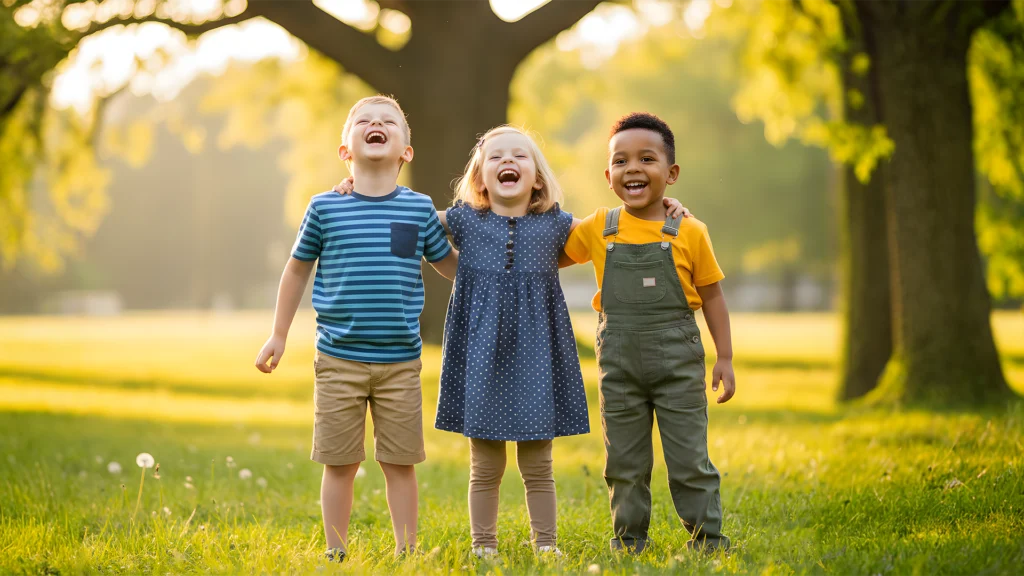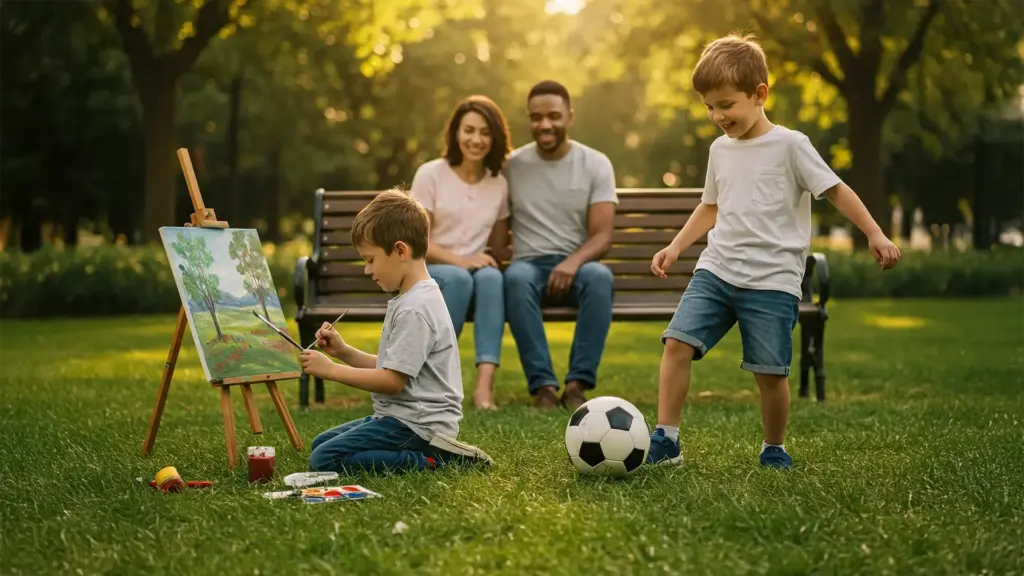If your twins have a twin and their best friend who seems like part of the family, you’ve witnessed the “third twin” effect. This unique bond goes far beyond a typical childhood friendship. It is a fascinating sociological dynamic that offers huge benefits for your children’s development. This article will guide you through understanding this special relationship. You will learn the psychological reasons why this trio forms so naturally. We will also explore the benefits and potential challenges of this close-knit circle. Finally, you will get practical strategies to support this important friendship. Understanding this dynamic helps you nurture your twins’ social and emotional growth.
What is the “Third Twin” Phenomenon? More Than Just a Best Friend
The “third twin” phenomenon describes a deep social integration. It occurs when a close friend is fully absorbed into the twins’ unique world. This child becomes an honorary member of the twin subsystem.
This friend understands the subtle cues and private language of the twins. They navigate the twin bond with surprising ease. The trio often functions as a single, cohesive unit in social settings.
Key characteristics define this special relationship. First, there is an intense level of loyalty and inclusion. The twins will defend their friend as if they were a sibling. Second, the group develops its own shared routines and inside jokes.
This dynamic is different from other friendships. The friend doesn’t just play with the twins; they operate within their bond. Parents often notice this child is the only outsider consistently granted this level of access.
Recognizing this phenomenon is crucial for parents. It helps you appreciate the significance of this connection. This friendship plays a vital role in your twins’ social development. Understanding it allows you to support this healthy dynamic effectively.
Why it Happens: The Social and Psychological Drivers
The “third twin” dynamic doesn’t occur by accident. Several powerful social and psychological factors drive this unique friendship formation. Understanding these reasons helps parents support this natural process.
The Need for External Social Validation
First, twins often seek confirmation beyond their own pair. They use their twin and their best friend as a social mirror. This friend provides an outside perspective on their shared experiences.
The friend helps validate their thoughts and feelings. This external feedback is crucial for healthy development. It reinforces that their twin-world view connects to the broader social environment.
Expanding the Twin Unit: Safety in Numbers
Next, adding a third member creates a more stable social unit. A trio feels safer than a pair when venturing into new social situations. The friend acts as a buffer against potential social challenges.
This expansion allows twins to engage with peers more confidently. They can maintain their close bond while slowly expanding their circle. The friend provides a secure bridge to the wider world of friendships.
The Friend as a Bridge to the Wider Social World
The chosen friend often possesses strong social skills. They naturally connect the twins to other children and groups. This helps twins develop crucial social competencies they might otherwise miss.
This bridge function is especially important in school settings. The third twin helps navigate complex classroom dynamics. They facilitate interactions that might be challenging for the twin pair alone.
Balancing the Twin Dynamic
Sometimes a third friend helps rebalance intense twin relationships. They can diffuse sibling rivalry or reduce co-dependent tendencies. The friend introduces new ways of interacting and problem-solving.
This balancing act promotes healthier individual development. Each twin learns to relate to someone outside their primary bond. These experiences foster independence and self-confidence.
The formation of this trio is a positive developmental sign. It shows your twins are building crucial social skills. This natural expansion of their world should be encouraged and supported.
The Benefits: How a “Third Twin” Supports Healthy Development
The twin and their best friend dynamic offers significant advantages for social and emotional growth. This unique trio configuration supports development in ways that other friendships cannot. Understanding these benefits helps parents appreciate this special relationship.
Easing Separation and Promoting Independence
First, the third twin helps twins practice time apart in a safe way. They can separate from each other while still maintaining a close connection. This builds confidence for future independent activities.
The friend provides a security bridge between togetherness and autonomy. Twins learn they can function independently without losing their special bond. This is a crucial step in developing healthy individuality.
Providing a Neutral Perspective and Reducing Conflict
Next, the friend often acts as a natural mediator during disagreements. They bring an outside viewpoint to twin conflicts and sibling rivalry. This can help resolve disputes more quickly and fairly.
The third child introduces new problem-solving strategies to the pair. They model alternative ways to handle disagreements and share resources. This reduces the intensity of conflicts between the twins.
Enhancing Social Skills and Empathy
This trio dynamic requires advanced social negotiation skills. Twins learn to consider a third person’s feelings and perspectives consistently. This practice builds stronger empathy and social awareness.
The friend exposes twins to different family cultures and traditions. This broadens their understanding of the world beyond their immediate experience. These exposures are valuable for social development.
Strengthening Communication Abilities
The third twin forces the pair to verbalize their private understandings. They must explain their twin shorthand to an outside party. This practice strengthens communication and language skills.
The friend often helps interpret the twins’ interactions for others. They become a translator between the twin world and the broader social environment. This role enhances their own social intelligence too.
Building Resilience Through Diverse Relationships
Experiencing different relationship dynamics builds emotional flexibility. The twins learn to adapt to various social situations and expectations. This flexibility is key to developing resilience.
The trio configuration provides a safety net during social challenges. If one relationship is strained, the other two can provide support. This reduces social anxiety and encourages risk-taking.
These benefits show why supporting this friendship is so valuable. The third twin relationship is a powerful tool for healthy development. It helps twins navigate the complex journey toward balanced independence.
Navigating the Challenges: Balancing the Trio Dynamic
While the twin and their best friend dynamic offers many benefits, it also presents unique challenges. Parents play a crucial role in helping maintain balance within this special trio. Understanding these potential pitfalls allows for proactive support.
The “Third Wheel” Risk: Avoiding Exclusion
First, parents must watch for exclusion patterns within the group. Sometimes two members may unintentionally pair off, leaving one feeling left out. This can happen with either the friend or one of the twins.
Rotate activities to ensure all pairings get equal attention. Encourage games that require three participants working together. This prevents any single child from feeling like an outsider in the group.
Managing Shifting Alliances and Jealousy
Next, be prepared for natural shifts in alliance within the trio. The friend might feel closer to one twin at different times. This is normal but requires sensitive handling.
Acknowledge that jealousy may surface among all three children. Validate these feelings while encouraging empathy and communication. Help them understand that relationships naturally ebb and flow over time.
When Parents Need to Step In (and When to Step Back)
Intervene when you notice consistent patterns of exclusion or upset. Help the children develop conflict resolution strategies they can use themselves. Model respectful communication and fair play during family activities.
However, also know when to let the children work things out independently. Natural social negotiation is valuable for their development. Provide guidance but allow them space to practice relationship skills.
Maintaining Individual Friendships Outside the Trio
Encourage each child to maintain separate friendships beyond this core group. This prevents over-dependence on the trio dynamic and ensures broader social development. Schedule individual playdates for each twin and the friend separately.
Support the friend’s relationships with other children outside the twin pair. This helps maintain healthy boundaries and prevents friendship burnout. A balanced social life benefits all three children involved.
Communicating with the Friend’s Parents
Maintain open communication with the third twin’s parents. Share observations about the children’s interactions and any concerns. Coordinate approaches to support the friendship consistently across both households.
Establish clear expectations about supervision, routines, and boundaries. This consistency helps the trio dynamic flourish in both environments. United support from all adults creates the healthiest foundation.
Evidence-Based Guidance for Parents
Supporting the twin and their best friend dynamic requires thoughtful strategies. These evidence-based approaches will help you nurture this special relationship. They promote healthy development for all three children.
Fostering Inclusive Environments at Home
First, create physical spaces that welcome the third child. Keep an extra seat at the table and snacks for their visits. This small gesture makes the friend feel like part of the family.
Establish house rules that apply equally to all three children. Consistency helps prevent jealousy or perceived favoritism. Clear expectations create a fair environment for everyone.
Communicating with the “Third Twin’s” Parents
Next, maintain open communication with the friend’s family. Share observations about the children’s interactions and bond. Coordinate approaches to support the friendship across both households.
Discuss schedules, boundaries, and expectations together. United support from all adults creates stability. This consistency helps the trio dynamic flourish in both environments.
Recognizing a Healthy vs. Unhealthy Dynamic
Watch for positive signs like laughter and shared decision-making. Healthy trios rotate activities and include everyone equally. All children should feel valued within the group.
Be alert for warning signs like exclusion or constant conflict. Address any bullying behavior immediately. Seek professional guidance if the dynamic causes ongoing distress.
Supporting Individual Relationships Within the Trio
Schedule one-on-one time for different pairings within the group. Encourage each twin to have individual time with the friend. This strengthens all relationships within the triangle.
Support separate friendships outside the core trio as well. This prevents over-dependence on the primary dynamic. Balanced social circles benefit all children involved.
Modeling Positive Conflict Resolution
Teach and demonstrate healthy ways to resolve disagreements. Show how to use “I feel” statements and active listening. These skills help the trio navigate inevitable conflicts.
Intervene when necessary to guide problem-solving processes. Then step back to let them practice independently. This builds their relationship skills over time.
Your support helps create a nurturing environment for this special bond. The third twin relationship can be incredibly valuable when guided properly. Your involvement makes a significant difference in its success.
Real-Life Stories: The “Third Twin” from Childhood to Adulthood
Real-world examples show the lasting impact of this special bond. These stories from parents and twins illustrate the third twin phenomenon across different ages. They reveal how these relationships evolve over time.
Elementary School: Sarah’s Story
Sarah’s twin boys met their best friend in kindergarten. “By first grade, Leo was practically living with us,” she recalls. The trio did everything together from homework to holidays.
“The teacher called them the ‘three musketeers’,” Sarah says. Leo understood the twins’ unique communication style. He could translate their needs to other children and adults.
This friendship helped the twins separate comfortably in classroom settings. They gained confidence through Leo’s social bridge-building. The trio remains close into middle school today.
Middle School Challenges: The Parent’s Perspective
Mark witnessed his daughters’ trio navigate social complexities. “Middle school was tough when the friend joined a different club,” he explains. There were periods of tension and renegotiation.
“The girls learned valuable conflict resolution skills,” Mark notes. They had to balance loyalty with individual interests. This experience prepared them for high school social dynamics.
The friendship survived these challenges and grew stronger. All three girls learned to support each other’s individual growth.
High School to Adulthood: A Twin’s Reflection
Emma, now in college, reflects on her childhood third twin. “Jake was our buffer and our bridge,” she shares. He helped her and her sister develop separate identities.
“In high school, Jake encouraged us to join different activities,” Emma says. He knew when to push them apart and when to bring them together. This support was crucial for their independence.
Today, Jake remains their closest family friend. He attends family events and holidays. The bond formed in childhood continues to enrich their adult lives.
The Long-Term Impact
These stories show the enduring nature of these relationships. The third twin often remains part of the family into adulthood. They become trusted confidants and lifelong friends.
The benefits extend far beyond childhood social development. These relationships provide lasting emotional support and connection. They become part of each person’s core support system.
Parents play a crucial role in nurturing these bonds early. Your support helps create friendships that can last a lifetime. The investment in these relationships pays dividends for years.
Conclusion: Celebrating the Expansion of the Twin Bond
The third twin phenomenon represents a beautiful evolution of the twin relationship. This special friendship strengthens rather than threatens the original bond. It provides crucial social and emotional benefits for all children involved.
Parents should view this trio as a positive developmental milestone. It shows your twins are building healthy social skills and independence. Your support helps this unique dynamic flourish properly.
Celebrate when your twin and their best friend form this deep connection. This expanded bond enriches their childhood experiences significantly. It creates memories and friendships that can last a lifetime.
Embrace this natural expansion of your twins’ social world. Your guidance helps create a nurturing environment for all three children. This support fosters healthy development and lasting relationships.



